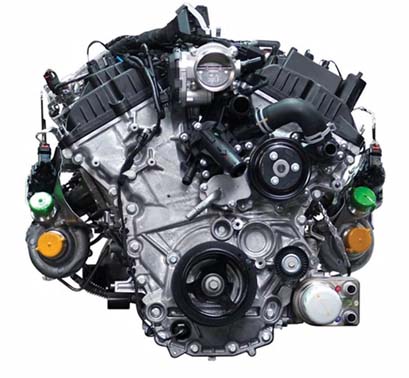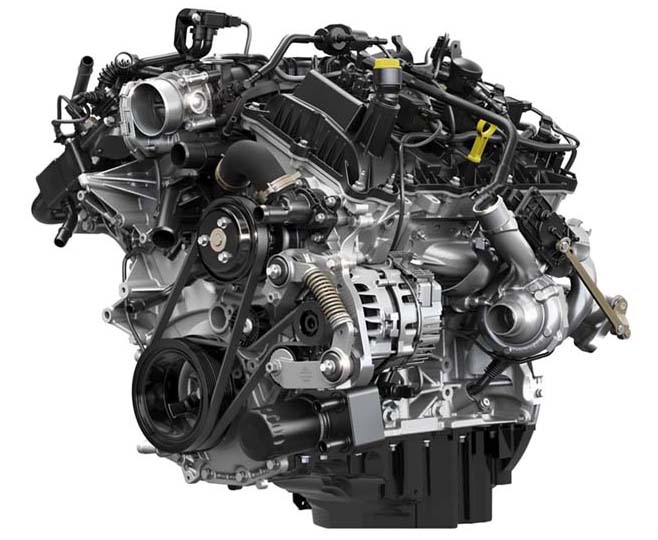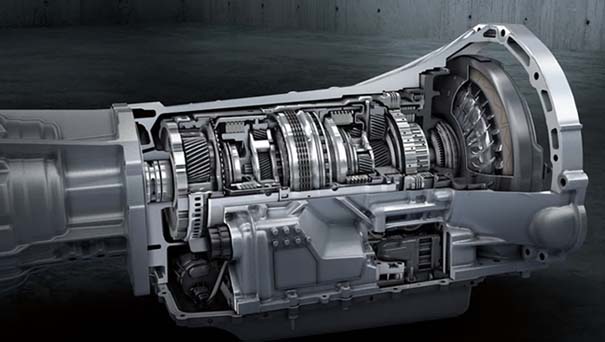Over the past 14 years, the 3.5L EcoBoost engine has proven its reliability over many thousands of miles in Ford F-150s and other vehicles when properly maintain. If owners follow the maintenance schedule, especially the recommended oil and oil filter changes, the trouble-free mileage of the 3.5 EcoBoost engine ranges from 150,000-200,000 miles. In fact, oil change intervals are especially important because turbochargers are very aggressive on engine oil. Since carbon buildup is common with direct fuel injection, Ford has modified its Ford EcoBoost engines through the years to alleviate this problem. Here's how it happened
First Generation: 3.5L EcoBoost Engine
The 3.5L EcoBoost V6, a gasoline direct-injected turbocharged engine, was introduced in 2007 as the TwinForce engine. The engine was intended to replace the large displacement V8 with a V6 of equivalent power and torque at a cheaper price that used less fuel and emitted fewer harmful substances into the air, according to Motor Reviewer.
This first Ford EcoBoost aluminum block engine was specifically designed with low friction and efficient combustion. The engine featured high-strength steel sleeves and forged steel I-beam connecting rods and crankshaft with oil jets spraying the underside of the high-strength, low-friction coated aluminum pistons.
The aluminum cylinder heads had four intake valves per cylinder and vent-roof combustion chambers with the injectors placed below the center of the intake valves. One of the two overhead camshafts had an extra lobe driving a high-pressure fuel pump that injected fuel at pressures up to 2,150 psi.
The main components of the 3.5L EcoBoost are the twin parallel-mounted turbochargers attached to the high-strength cast iron low internal volume exhaust manifolds. Peak torque obtained at only 2,500 rpm with small, variable-vane high-pressure turbos reduced turbo lag.
Second Generation: 3.5L EcoBoost Engine
Ford redesigned the 3.5L EcoBoost in 2017 with the addition of multi-port fuel injection and new turbochargers. The multi-port fuel injection system, combined with direct injection, raised the fuel output needs, but maintained engine performance during long mileage drives by preventing carbon buildup on the intake values reports the Motor Reviewer.
 This generation's turbocharger features a turbine wheel and an electrically activated wastegate valve that diverts exhaust gases away from turbine wheel to regulate maximum boost of turbo. These modifications on this generation of Ford EcoBoost engine reduced turbocharger lag, allowing for peak torque faster.
This generation's turbocharger features a turbine wheel and an electrically activated wastegate valve that diverts exhaust gases away from turbine wheel to regulate maximum boost of turbo. These modifications on this generation of Ford EcoBoost engine reduced turbocharger lag, allowing for peak torque faster.
This 3.5L EcoBoost engine also has two timing chains, one separate chain for driving each cylinder block. The increased thickness of side plates on the timing chains made the chains more durable and less prone to stretch. The roller-finger follower valvetrain and light hollow camshafts of the cylinder heads helped reduce friction.
With less friction, the compression ratio of the second generation 3.5L EcoBoost was increased from 10.0:1 to 10.5:1. These improvements along with a 10-speed automatic transmission added 10 hp and 50 lb-ft of torque to F-150s with EcoBoost, while improving gas mileage.
Third Generation: 3.5L PowerBoost Full Hybrid
For 2021, Ford teamed the 3.5L EcoBoost twin-turbo V6 engine with a 35-KW electric motor and a 1.5-KWh lithium-ion battery mounted below the rear seat, saving passenger and box space. The integration of the 47-hp electric motor into the 10-speed automatic transmission enables electric-only driving with light loads and speeds up to about 10 miles per hour. Above these loads, the 3.5L PowerBoost Full Hybrid V6 engine and motor combine the effort of gas and electric energy into a single, torture-tested powertrain.

It is important to recognize that horsepower, torque, towing and payload are independent attributes that may not be achieved simultaneously.
Ford offers five other engines with the 10-speed automatic as standard on F-150s. The 10-speed also features three overdrive gears and selectable drive modes—Normal, Eco, Sport, Tow/Haul, Slippery, Trail in 2WD and 4WD, plus Deep Snow/Sand, Mud/Ruts in 4x4s and even Rock Crawl with the FX4 Off-Road Package.
Consumer organizations often test new vehicles for quickness from a dead start, especially hybrids. According to several online reviews regarding Ford Powerboost engines, the new F-150 PowerBoost Hybrid powertrain provides enhanced acceleration at low and mid ranges of the power band.
In Edmunds Electric Boogie: Driving the Redesigned 2021 Ford F-150 with Its New Hybrid Powertrain, Travis Langness reports, the PowerBoost hybrid "Power delivery is smooth on long grades and impressive when you mash the throttle. But at low speeds, the transition from electric to gasoline power could be smoother." Edmunds tested a 2021 Platinum-trimmed 4WD Supercrew F-150 with the new hybrid powertrain. The F-150 reached 60 mph in 5.7 seconds, and this is reportedly "significantly quicker than any similarly equipped pickup."
Jared Rosenholtz evaluated the F-150 Hybrid in the article, 2021 Ford F-150 Test Drive Review: Electrifying A Legend. The performance of a 4WD F-150 crew cab with the hybridized 3.5-liter PowerBoost V6 was also tested by carbuzz.com. According to the editorial, the F-150 reached "60 mph in just 5.4 seconds, making it the most torque-rich F-150 ever.
 In The Car Connection Expert Review, Senior Editor Robert Duffer, reports, "The hybrid makes 430 horsepower and 570 pound-feet of torque, has plenty of pop off the line, and rides on such a smooth shifting transmission that it's hard to notice the shifts after third gear." The test 2021 F-150 Supercrew cab had rear-wheel drive and a 6-foot-6-inch bed. The Edmunds review also noted the 10-speed automatic transmission was "smooth and quick."
In The Car Connection Expert Review, Senior Editor Robert Duffer, reports, "The hybrid makes 430 horsepower and 570 pound-feet of torque, has plenty of pop off the line, and rides on such a smooth shifting transmission that it's hard to notice the shifts after third gear." The test 2021 F-150 Supercrew cab had rear-wheel drive and a 6-foot-6-inch bed. The Edmunds review also noted the 10-speed automatic transmission was "smooth and quick."
The 3.5L PowerBoost Full Hybrid powertrain with 2WD can attain 25/26/25 (city/highway/combined) miles per gallon, making it the most efficient in city driving. The rated gas mileage for the 4WD is 24/24/24 miles per gallon. Considering these mileage ratings and the 30.06-gallon gas tank on Supercrew hybrid F-150 pickups, the driving distance for a full tank can range up to 765 miles with the 2WD models on recommended 87 octane fuel.
The 3.5L twin-turbo V6 engine with the 47-hp electric motor, the 1.5-kw lithium battery and the 10-speed automatic transmission are just the beginning of innovations in the 2021 3.5L PowerBoost Hybrid F-150 Ford pickups. Ford further enhanced the F-150 Supercrews with the new 2.4-kw onboard generator (used by many Texans during the snow 0f 2021), the available 12-inch touchscreen, the radical efficient work-interior, and several electronic driver-assist safety features (See Ford Co-Pilot360 Provides Comprehensive Safety Assistance).
According to Jared Rosenholtz in the carbuzz.com review, "The F-150 has been the best-selling truck in America for 43 years, and after driving a Platinum-trimmed Ford F-150 with the new PowerBoost hybrid system … we don't see that changing any time soon." The test-driven 2021 F-150 scored a BuzzScore of 9.1 (The best car in its class.***) from carbuzz.com.
Maintain Your 3.5L Powertrains with Ford Protect Plans
With these new innovative hybrid and electronic driver technologies in Ford PowerBoost engines arriving on the scene, it becomes more important than ever to keep your expensive new or used Ford F-150 truck running longer with a Ford Protect ESP warranty, including PremiumCare, ExtarCare, BaseCare and PowertrainCare. You may also want to consider getting a Premium Maintenance Plan for high-quality recommended maintenance of your electric, hybrid, gas and diesel vehicles.
Check with one our Zeigler Factory Plans experts who can prepare an instant quote for you using our Quick Quote Calculator. You also can obtain a quote for service warranty or maintenance plans by entering your vehicle information in the Custom Quote section in the right column of this page.
*570 lb-ft of torque: Torque is calculated via combined performance of the engine and electric motor(s) with peak battery power. The calculations use SAE 31349 engine results and Ford electric motor dyno testing. Your results may vary.
**12,700 lbs maximum towing: Maximum owing is based on the F-150 XL PowerBoost Supercrew, 4x2 with the Max Trailer Tow Package. Maximum towing varies based on cargo, vehicle configuration, accessories and number of passengers.
***F-150: Class is in the Full-Size Pickups less than 8,500 lbs. GVWR.
2-11-22